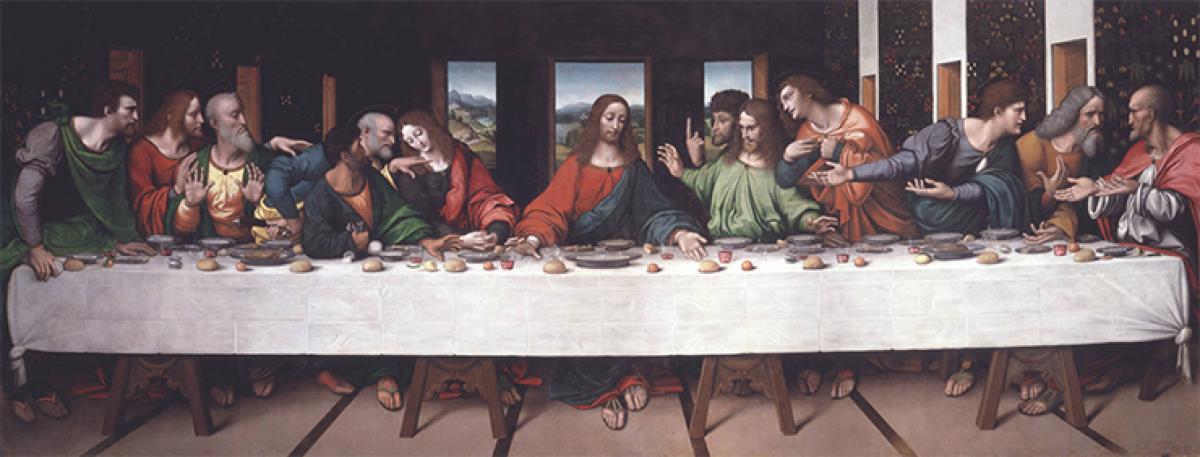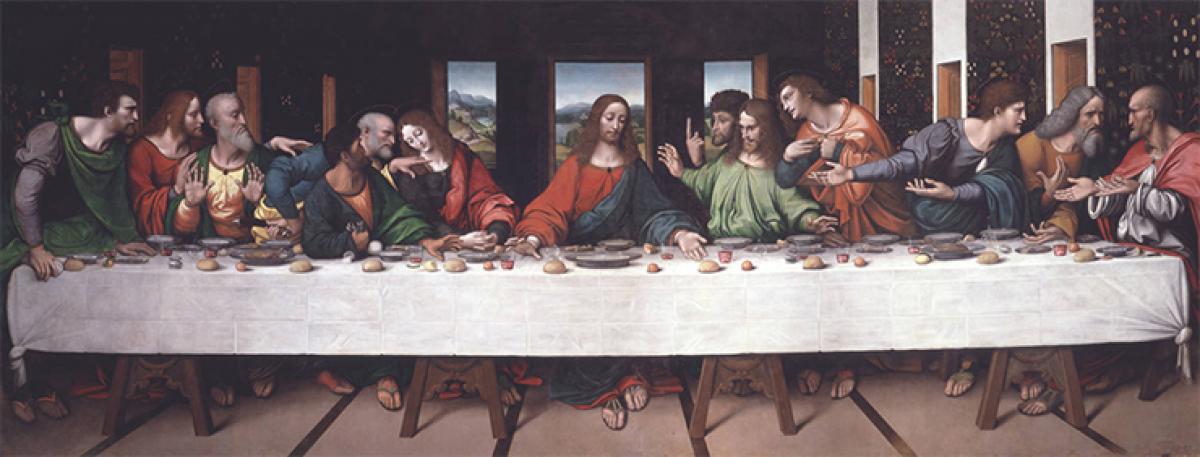Live
- G20 Leaders Will Talk About Climate, Taxes, and Trump's Return in Brazil
- COP29: CDRI announces $8 million funding for 12 projects to address climate crisis
- Anti-Telgu remarks: Actor Kasthuri Shankar moves court for bail
- Samsung AR Smart Glasses Set to Launch in 2025, Featuring Ray-Ban Meta-Like Design
- Kerala Industries Minister confident that new policy will boost plantation sector
- Madras HC plans inter-departmental monitoring committee to combat drug use in TN
- Bihar: Spotted deer dies due to heart attack in Banka district
- Mushtaq Ali T20: Shami to spearhead Bengal bowling attack, Gharami named captain
- Kharge's clarion call to oust Maharashtra's BJP-backed MahaYuti
- Why Ukraine’s Use of US Missiles Against Russia Could Lead to World War 3
Just In

x
Highlights
He sees the beauty of a human face, and searches for the cause of that beauty; which must be more beautiful.”-Ralph Waldo Emerson, Montaigne
Late in the fifteenth century, Leonardo da Vinci, son of a Florentine lawyer, was living in Milan and thinking about facial expression more closely than perhaps anyone had before him, and few have done since. His drawings of the muscles of the face wouldn’t be bettered for centuries.

He sees the beauty of a human face, and searches for the cause of that beauty; which must be more beautiful.”-Ralph Waldo Emerson, Montaigne
When I was taught facial anatomy as a medical student most of the cadavers we dissected were those of old men with thick facial skin, stiffened by stubble. Their faces might have been tough as hide, but the muscles that lay immediately beneath that skin were fragile: delicate fronds of salmon pink laced through buttery subcutaneous fat.
When trying to demonstrate the muscles that give expression to our faces I’d have to proceed with care; a slip of the scalpel and they’d be stripped off with the skin. There were differences between individual cadavers. Though death had relaxed their expressions, the development in their facial muscles suggested something of each individual’s attitude when alive.
The muscles with the greatest variation were zygomaticus major and minor, the function of which is to spread the corners of our mouths to a smile. Sometimes those would be thick and well defined, implying a life filled with laughter. At other times zygomaticus would be shrivelled to withered little strings, suggesting years of misery.
Occasionally, one side would be well developed and the other not, indicating survival following a stroke, or perhaps Bell’s palsy — a paralysis of just one side of the face because of a damaged nerve. Other muscles could give hints about each person’s attitude when alive: an unusually well-developed corrugator supercilli hinted at a perennially angry, knitted brow — from which we get the word supercilious.
The levutor lubii superioris alaeque misi— an extraordinarily long name for a tiny muscle — does exactly what it says if you can fight your way through the Latin: it lifts the upper lip and wing of the nostril in a snarl. The concentric fibres of orbiculuris oculi, arranged like Saturn’s rings around each eye, are needed not just for actions such as blinking, which protects the eye surface, but when contracted more forcefully they help us squint against sunlight. They also contribute to ‘crow’s feet’ at the angles of our eyelids.
It’s because of variations in the way this muscle works that some people can wink with both eyes, and others only one. Frontalis fibres raise the eyebrows in horror or dismay and are the cause of the stave of lines that so often wrinkle the brow. Orbiculuris oris puckers the lips for a kiss, while depressor unguli oris, beneath each corner of the mouth, pulls a pout down into a frown. Sometimes I’d find a corpse whose frowning muscles had been built up to a depressing degree.
When I later became a demonstrator of anatomy, one of my jobs was to reveal these muscles in order to help students understand the way that stroke or palsy can affect the face, as well as give a grounding to those who’d one day perform Botox injections, facelifts or facial reconstructive surgery.
All in all I’ve probably dissected between twenty and thirty human faces, but never lost the sense of privilege it afforded. Exposing each layer of the face was a process of gradual revelation, journeying from the skin, so reminiscent of life, down to the skull, so emblematic of death. The very fragility of the facial muscles enforced a level of tenderness and respect.
Late in the fifteenth century, Leonardo da Vinci, the bastard son of a Florentine lawyer, was living in Milan and thinking about facial expression more closely than perhaps anyone had before him, and few have done since. His drawings of the muscles of the face wouldn’t be bettered for centuries.
As a painter and draughtsman he believed in accuracy of representation, and had realised that to excel as a portraitist he had to understand those muscles intimately. He also believed that muscles were in direct communication with the soul, and that the motions of the soul could be understood through an appreciation of the body: ‘The joint of the bones obeys the nerve, and the nerve the muscle, and the muscle the tendon, and the tendon the Common Sense. And the Common Sense is the seat of the soul.’
In about 1489 he was making sketches for a monumental statue of his patron’s father, Francesco Sforzaf as well as some notes for an anatomical treatise. His ambition was as unwieldy as it was magnificent, and his notes offer a glimpse of a mind churning with creative and intellectual energy, possessed by a will to comprehend every aspect of human being.
He intended his treatise to explain conception, pregnancy; normal and premature birth, the growth of children, the normal constitution and physiognomy of adult men and women, as well as provide a complete exposition of the veins, nerves, muscles and bones. Then he outlined how the changing expressions of the face would be the key to understanding the human condition: ‘Then in four drawings you will depict the four universal conditions of man, that is: joy with different ways of laughing, and draw the cause of the laughter; weeping in different ways, with their cause; fighting, with the different movements of killing; flight, fear, ferocity boldness, murder ...’
For da Vinci, to tabulate the actions of muscles expressing these emotions was to come close to understanding the divine source of emotions themselves. He was not interested in portraying bland representations of beauty: he wanted to capture faces as they are, as they move, whether ugly or beautiful, and if those expressions were extreme — all the better.
To anatomise was to come closer to God: ‘And you, man, who witnesses in this labour of mine the marvellous works of nature if this his composition appears to you a marvellous piece of work, you should regard this as nothing compared to the soul that dwells within that architecture.’
Later works like the Mona Lisa (1503-4) show just how sensitive Leonardo was to subtlety of facial expression. In the early 149os his studio for exploring these ideas was the refectory wall of a Milanese convent on which he was painting an impression of The Last Supper.
Other Renaissance Last Suppers had been rather staid, showing the apostles expressionlessly eating their dinner. To demonstrate the way in which emotion animates expression, da Vinci chose the moment of the Passover meal when Christ is said to have announced ‘one of you will betray me’…
From ‘Adventures in Human Being’, by Gavin Francis, publisher: Hachette, `399

Next Story
More Stories
ADVERTISEMENT
© 2024 Hyderabad Media House Limited/The Hans India. All rights reserved. Powered by hocalwire.com







